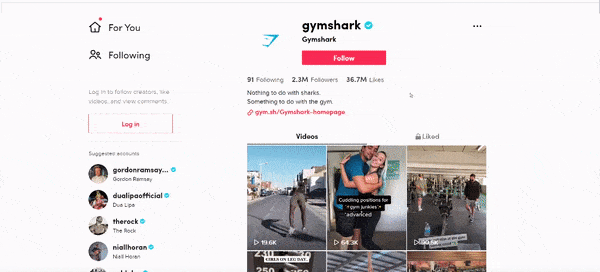If you’re producing content without a real strategy, you’re putting words, images, or videos into the ether that serve no purpose. Ultimately everything you produce should serve the end goal of driving awareness and transactions.
There are countless websites with blogs that haven’t published anything in years, and there are even more dormant social profiles that haven’t posted, possibly ever. Created simply so business owners can say “yes, we’re on Facebook”.
The content you produce has to be tied back to a purpose and achieving business goals. These goals could be greater engagement on social media, driving more traffic from organic search, or fueling your sales funnel. With the right content marketing strategy, it’s possible to increase customer engagement, generate leads, and grow direct sales.
The Importance of an Ecommerce Content Marketing Strategy
If we break it down to its very basic form, content marketing is the process of creating original, high-quality content aimed at your target audience, appealing to their interests, and addressing their pain points. From a content point of view, it’s not a hard sell. For ecommerce websites that can be done with PPC, Display, or affiliate activity. These channels will most likely be KPI’d on transactions or revenue generated.
Content is usually a soft sell by providing valuable information or entertainment that earns goodwill and engagement. Here KPIs will more likely be traffic, reach, and engagement. The ultimate goal of this engagement though is to both convert potential customers into paying customers and to retain existing customers by building brand advocacy. In a nutshell, the whole strategy behind the content you produce can be summarized below:
- Addressing your target market’s needs and problems
- Showing you are a reliable source of information
- Positioning yourself as an authority that can help them
- Converting interest to transactions
- Building valuable ongoing relationships
- Building your brand identity
When you read it in five steps, it sounds easy. In reality, a content strategy takes a ton of planning, patience, and persistence. Don’t be afraid to test things either. By opting for a test-and-learn approach and refining your content marketing according to what you have learned from previous efforts or mistakes, you can continuously improve its effectiveness. The benefits of a well-executed content strategy for ecommerce include:
- Driving new traffic to your website
- Encouraging and building trust in your brand
- Driving transactions
- Creating evergreen content that will always be valuable
Without a strategy behind the content you produce, there will be a risk your content will lack real focus and purpose. This could lead to a lack of clarity, potentially causing confusion within your messaging and turning potential customers off. You may even lose some ground to competitors who have a strategy in place.
Building Your Content Strategy
Step 1: Identify your target audience.
To create effective ecommerce content you need to know who your buyer is. This can be done by creating a buyer persona, or maybe even a few of them. This persona is a fictionalized representation of buyers based on any real data and marketing insights you can get access to. After you’re happy with the persona you’ve created, you can start to create content aimed at them. Of course, here you will need to take into account what part of the purchase stage they are in.
Most ecommerce content is aimed at the top of the sales funnel, so you need to be careful with sales messaging and focus on providing value and solutions. If you are aiming at growing your business, pay meticulous attention to the marketing funnel. Think of how you can refine your sales funnel to provide your consumers with personalized customer service and consistent experience at every stage of their journey, and it will add you points. When you’re building your persona, you’ll want to think about the following aspects:
Demographics: Gender, age, location.
Personality: Are they super productive? Skeptical or optimistic? Identifying personality traits like these will guide messaging and tone of voice they will resonate with.
Pain points: This is a big one. What currently frustrates your customers? What are they struggling with? If you know the answers to these questions, you can provide the solution.
Content consumption: Knowing where your customers are, the websites they visit, the apps they consume content on will help you identify the key areas you need to be and the type of content that needs to be produced for these specific channels.
When you enter the mindset of your target market, you can easily create a content strategy that is mapped out against their paint points and consumption habits. You’ll also be able to create a customer journey map with their buying process in mind so you can create content for each stage of their journey.
Step 2: Identify their online habits.
Remember, the whole goal of producing content is to get more eyeballs on your brand. That’s why you need to figure out where your audience spends most of their time, but also how they use these platforms. If you want to target the younger demographics, you may think Snapchat is the best channel to focus on and distribute your content. But you could be making a mistake. Do you know exactly how they are using Snapchat? Research has shown that 49% of Generation Z women say that they prefer to use Snapchat for sending videos of themselves with another 43% saying they prefer using Snapchat for posting selfies. So, a large proportion of this audience doesn’t use Snapchat to engage with brands.
In the same report, 48% of Generation Z women said that Instagram was their preferred social network for engaging with and following brands. Even though Snapchat has a greater marketing penetration of your target audience, it doesn’t matter if they’re not using that platform to interact with businesses online. It would also be the case if you wish to target those between the ages of 40-55. LinkedIn may look like the best choice, but this is not used for purchases or engaging with brands.
Step 3: Create content and distribute.
Once you have your content all planned out, you need to start thinking about how to get as many eyeballs on it as possible. This can be through sharing on social media, including blogs in emails you send, utilizing influencers to amplify your reach, and even boosting the odd post. You’ll need to think about what type of content works best where, and where it can have the best impact on potential customers. Take a look at the below content marketing funnel, you’ll see most of the content we are going to talk about is either TOFU or MOFU. Again, there’s not much selling going on in these stages. It’s purely focused on engagement.
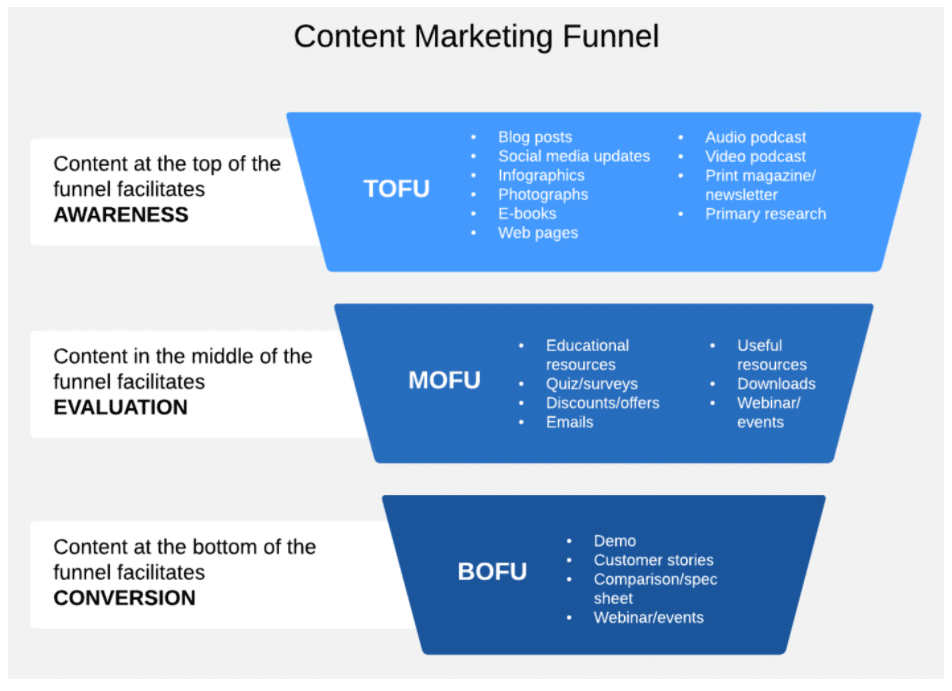
A quick note on the bottom of the funnel: Here is where other channels such as PPC, affiliate marketing will be key for ecommerce stores. This is where people put their money where their interest and trust is. At this purchase stage, it also makes sense to use a live chat or chatbot so you are readily available to answer any last-minute questions or barriers to purchase. Basket abandonment emails, retargeting ads, or any onsite personalization are also in your arsenal at this stage.
Examples of an Ecommerce Content Strategy
What happens when you nail your content strategy? Well, in short, you can certainly expect a lot more traffic, you’ll build your brand identity, and you may even get a few more customers along the way. There are a variety of places ecommerce stores need to be producing content for. Below we’ll take a quick look into one company that is pretty much doing everything right. You’ll see they are producing content for every channel that their target audience is on. It’s getting great engagement, the messaging is on point, and no doubt building great relationships with both existing and potential customers.
GymShark is a shining example of an ecommerce website using a complete content marketing strategy to get in front of and engage with its audience effectively. Essentially any gym-goer or active person may be interested in buying GymShark clothing. So, GymShark ensures they get in front of this audience by providing useful content that its target audience is searching for. This goes back to finding and solving problems.
Blog
Starting a blog is easy to do. But again planning here is key. You’ll need to spend a good deal of your time carrying out keyword research and identifying your target keywords. There are plenty of tools that can help you do this, such as ahrefs or SEMRush. Gymshark has a dedicated sub-domain to store all its informational content. A quick look at their blog, and you can see it drives a considerable amount of traffic for them, according to ahrefs.

If we break down what type of content is driving this traffic, you can see it’s all helpful content that gym-goers are seeking answers for.
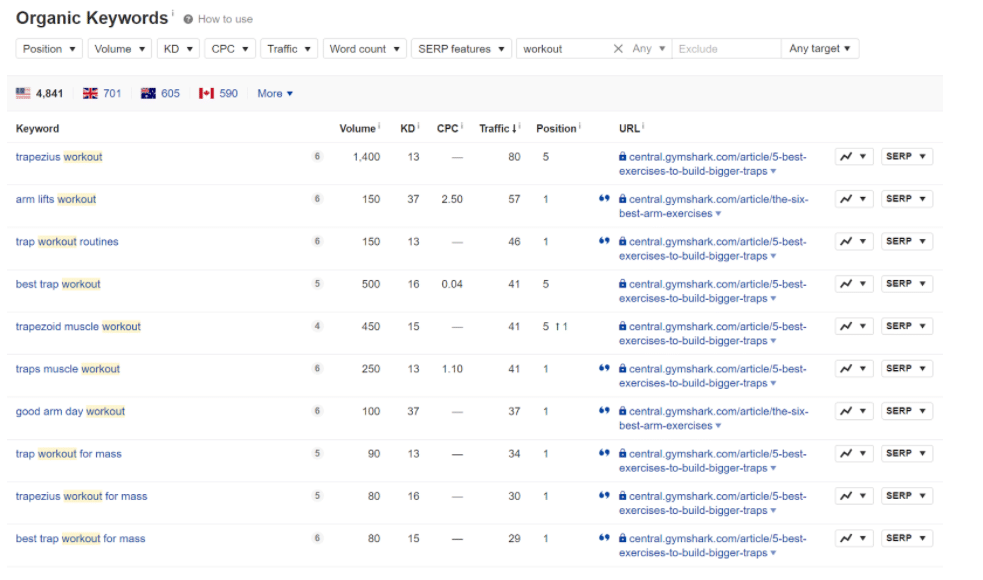
Without a blog, GymShark will be limiting its website to appear for purely commercial terms such as “men’s gym t-shirt.” Adding a blog means they can go after every fitness-related term in the world if they wished to. What’s more, this traffic is also worth an estimated $48K.
Having a consistent flow of content is a key part of any SEO strategy or package so should not be overlooked for ecommerce websites. No matter what industry you are in, people will be searching for answers to questions. A blog is your chance to provide answers to these questions, build goodwill and traffic.
Gymshark tailors its posts to whatever social media profile it’s posting from. They are active on pretty much every social media platform around and post consistently and regularly. If you wish to do the same, you’ll need a lot of ideas and probably the help of a social media posting tool. Facebook isn’t all about content though, you might be able to use Facebook Marketplace to sell your products.
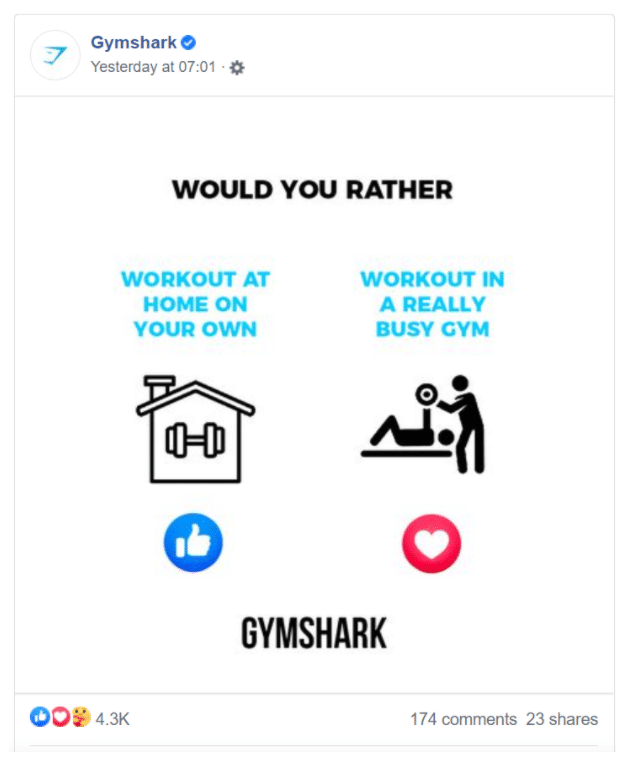
Yep, they are even on LinkedIn as well. You can see they use the same type of post and design the question to be tailored to the platform’s audiences.
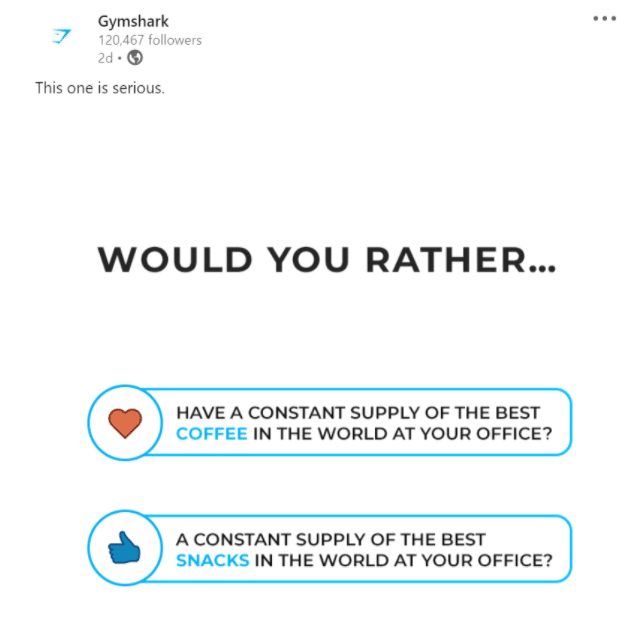
As well as posts, Gymshark uses LinkedIn to share staff updates and career advice, which completely caters to LinkedIn’s audience and the type of content they expect to see.
If you’re planning on using Instagram, your photography game needs to be on point. This is one of the most visual platforms out there, and you don’t want people scrolling through your content like it doesn’t exist. Of course, GymShark can heavily rely on its many influencers here to create engaging Instagram photos and provide a steady flow of content. If you’re working with influencers as well, great. If you’re not, Instagram can still be a vital channel for you, you’ll just need to get a bit creative.
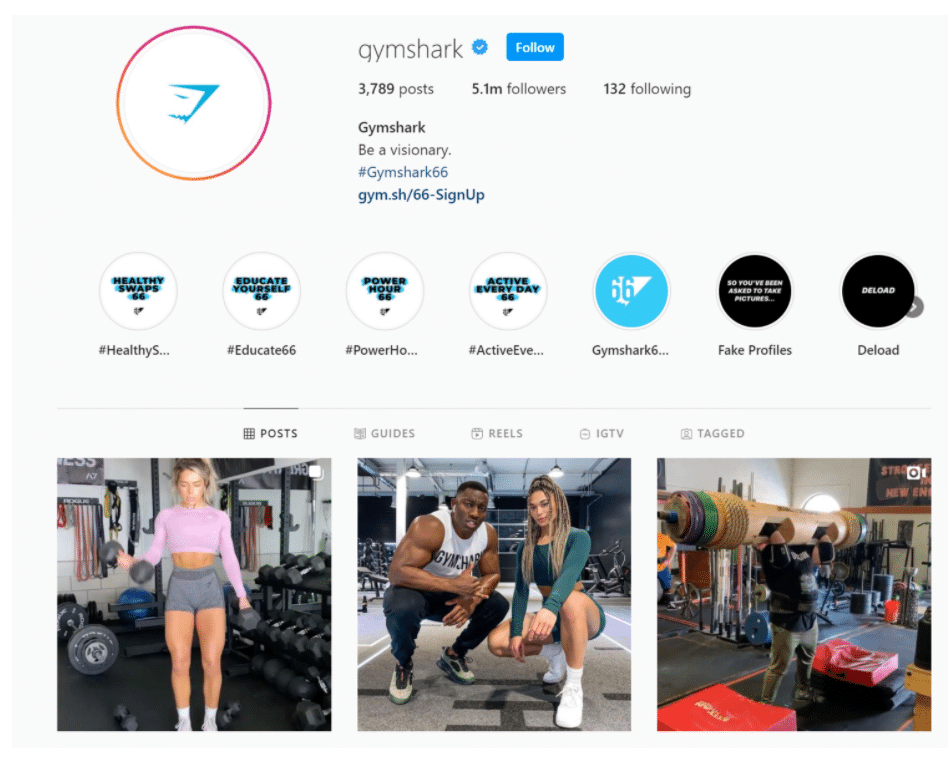
You’ll need a strategy here as well to grow your Instagram followers, especially if you don’t have the budget to work with influencers. So, some quick and easy ideas to incorporate into your social calendar are be the following:
- Ask your followers a question.
- Post a product tutorial.
- Go behind the scenes.
- Conduct an AMA.
- Conduct an interview with an industry leader.
- Jump on a trend.
- Cross post from other social media sites.
This is another social media platform that is heavily focused on visual appeal and images. It might not be the right fit for every ecommerce business out there. The whole experience on Pinterest is clickable, which means if you get it right, you can drive a significant amount of traffic to your website.
One of the best things you can do on Pinterest is tag your product or website images that show on walls, which automatically creates an underlying link that points to your specific product page. If the image is appealing and they like the look of your product, they can navigate straight to it and hopefully make a purchase.
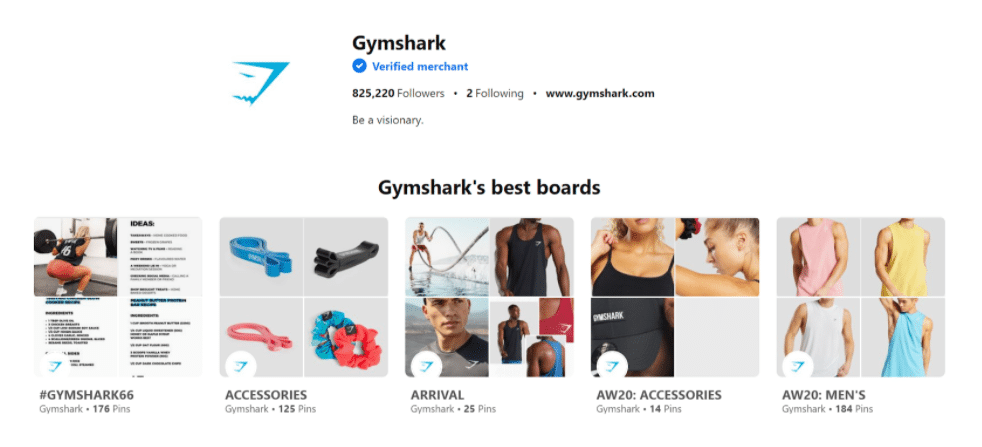
Gymshark splits boards into product types and collections. You also need to make sure you are utilizing catalogs. Catalogs allow you to turn all the products listed on your ecommerce site into shoppable Pins.
Gymshark has three different profiles that all serve different purposes. Social channels are often a place where consumers can and willingly share their experiences, both good and bad. For ecommerce stores, this mostly relates to customer service, chasing deliveries, or just general stock questions. By splitting out these channels, Gymshark can focus on what each profile is for, which will ultimately make their customers happier. Having a dedicated channel for customer services will, for the most part, give unhappy customers a place to get a quick resolution.
On Twitter, Gymshark doesn’t act like a brand. It acts like a person, someone who reflects the ideas and feelings of its buyers.
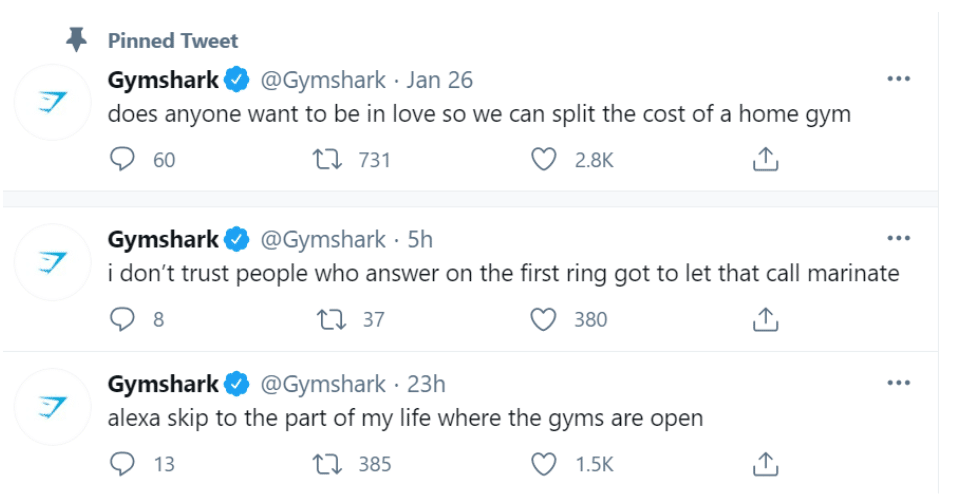
By tweeting like this you get much better engagement with your customers and potential buyers. If you’re a fan of a brand, who wants boring company update tweets?
Spotify
What do most people do when they work out? Listen to music. Gymshark of course knows this and has a bunch of playlists for Spotify users to engage with. They even have playlists specifically created by their most well-known influencers, which encourages those relationships between their fans and influencers, ultimately increasing the standing of Gymshark.
TikTok
TikTok has pretty much taken over social media this year. It’s another place where users can fall down a rabbit hole of content. This won’t be for all ecommerce brands, but if you can come up with some clever ideas or get involved with challenges you could quickly grow your following.
Gymhark’s TikTok is full of engaging and fun videos from its influencers. No sales messaging here — it’s purely entertainment and engagement. This is a perfect place as a brand to reflect your target audiences’ idiosyncrasies and behaviors. AKA, show a bit of personality!
YouTube
YouTube is still the end all, be all for video content. Videos are a great way to engage with your target audience and spread your brand message. It can be an expensive channel, as video production takes a lot of time and budget, but it’s definitely a rewarding channel if you get it right. Gymshark again consistently puts out videos and uses its influencers to create good content that gets engagement.
Now, not everyone has access to world-famous influencers, but you don’t need massive names in your space to grow your YouTube subscribers. Micro-influencers can be an option or even using a staff member that’s willing to go in front of a camera could be the easiest way to start. As long as you have a good idea that your audience should engage with, you should be good to go.
Closing Thoughts
Don’t be afraid to test and learn. Brands that have the best social profiles often don’t act like brands at all. If you can’t fully commit to a social media strategy or be willing to ruffle some feathers, you may be limited in what you can achieve.
If you’re fully committing to a content strategy, it’s a big project. You’ll need to book photographers, videographers, manage editors, your social media team, schedule posts, and more! Make sure you’re well equipped as a department to deal with all these tasks.
Although a social media tool can help you schedule posts, you may also want to consider having a task management tool or something like Asana, Trello, or Slack to help keep on top of tasks and team management.
Of course, your budget will always factor into this strategy but you can always get creative on a low budget as some of the examples above show.
Once you have identified your target audience, built your personas, and understood where your audience spends most of their time-consuming content, you can formulate a winning ecommerce content strategy. Coming up with some social content ideas can sometimes feel a bit daunting, but the above ideas should hopefully give you some inspiration.
